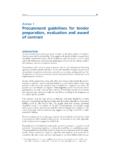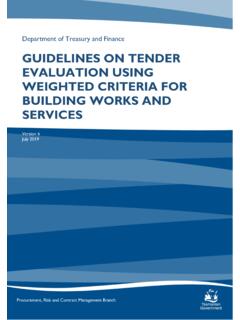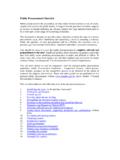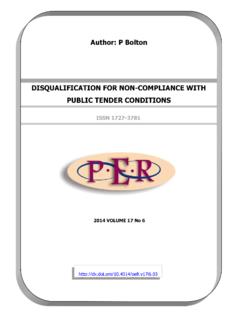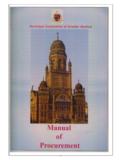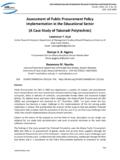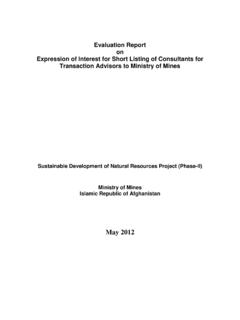Transcription of 18R-97: Cost Estimate Classification System - As …
1 Copyright 2005 AACE, Inc. AACE International Recommended Practices AACE International Recommended Practice No. 18R-97 cost Estimate Classification System AS APPLIED IN ENGINEERING, PROCUREMENT, AND CONSTRUCTION FOR THE PROCESS INDUSTRIES TCM Framework: cost Estimating and Budgeting Acknowledgments: Peter Christensen, CCE (Author) Larry R. Dysert, CCC (Author) Jennifer Bates, CCE Dorothy J. Burton Robert C. Creese, PE CCE John K. Hollmann, PE CCE Kenneth K. Humphreys, PE CCE Donald F. McDonald, Jr. PE CCE C. Arthur Miller Bernard A. Pietlock, CCC Wesley R.
2 Querns, CCE Don L. Short, II Copyright 2005 AACE, Inc. AACE International Recommended Practices AACE International Recommended Practice No. 18R-97 cost Estimate Classification System AS APPLIED IN ENGINEERING, PROCUREMENT, AND CONSTRUCTION FOR THE PROCESS INDUSTRIES TCM Framework: cost Estimating and Budgeting February 2, 2005 PURPOSE As a recommended practice of AACE International, the cost Estimate Classification System provides guidelines for applying the general principles of Estimate Classification to project cost estimates ( , cost estimates that are used to evaluate, approve, and/or fund projects).
3 The cost Estimate Classification System maps the phases and stages of project cost estimating together with a generic maturity and quality matrix, which can be applied across a wide variety of industries. This addendum to the generic recommended practice provides guidelines for applying the principles of Estimate Classification specifically to project estimates for engineering, procurement, and construction (EPC) work for the process industries. This addendum supplements the generic recommended practice (17R-97) by providing: a section that further defines Classification concepts as they apply to the process industries; charts that compare existing Estimate Classification practices in the process industry; and a chart that maps the extent and maturity of Estimate input information (project definition deliverables) against the class of Estimate .
4 As with the generic standard, an intent of this addendum is to improve communications among all of the stakeholders involved with preparing, evaluating, and using project cost estimates specifically for the process industries. It is understood that each enterprise may have its own project and estimating processes and terminology, and may classify estimates in particular ways. This guideline provides a generic and generally acceptable Classification System for process industries that can be used as a basis to compare against. It is hoped that this addendum will allow each user to better assess, define, and communicate their own processes and standards in the light of generally-accepted cost engineering practice.
5 INTRODUCTION For the purposes of this addendum, the term process industries is assumed to include firms involved with the manufacturing and production of chemicals, petrochemicals, and hydrocarbon processing. The common thread among these industries (for the purpose of Estimate Classification ) is their reliance on process flow diagrams (PFDs) and piping and instrument diagrams (P&IDs) as primary scope defining documents. These documents are key deliverables in determining the level of project definition, and thus the extent and maturity of Estimate input information. estimates for process facilities center on mechanical and chemical process equipment, and they have significant amounts of piping, instrumentation, and process controls involved.
6 As such, this addendum may apply to portions of other industries, such as pharmaceutical, utility, metallurgical, converting, and similar industries. Specific addendums addressing these industries may be developed over time. This addendum specifically does not address cost Estimate Classification in nonprocess industries such as commercial building construction, environmental remediation, transportation infrastructure, dry processes such as assembly and manufacturing, soft asset production such as software development, and similar industries. It also does not specifically address estimates for the exploration, production, or transportation of mining or hydrocarbon materials, although it may apply to some of the intermediate processing steps in these systems.
7 The cost estimates covered by this addendum are for engineering, procurement, and construction (EPC) work only. It does not cover estimates for the products manufactured by the process facilities, or for research and development work in support of the process industries. This guideline does not cover the Copyright 2005 AACE, Inc. AACE International Recommended Practices cost Estimate Classification System As Applied in Engineering Procurement, and Construction for the Process Industries February 2, 20052 of 9significant building construction that may be a part of process plants. Building construction will be covered in a separate addendum.
8 This guideline reflects generally-accepted cost engineering practices. This addendum was based upon the practices of a wide range of companies in the process industries from around the world, as well as published references and standards. Company and public standards were solicited and reviewed by the AACE International cost Estimating Committee. The practices were found to have significant commonalities that are conveyed in this addendum. cost Estimate Classification MATRIX FOR THE PROCESS INDUSTRIES The five Estimate classes are presented in figure 1 in relationship to the identified characteristics. Only the level of project definition determines the Estimate class.
9 The other four characteristics are secondary characteristics that are generally correlated with the level of project definition, as discussed in the generic standard. The characteristics are typical for the process industries but may vary from application to application. This matrix and guideline provide an Estimate Classification System that is specific to the process industries. Refer to the generic standard for a general matrix that is non-industry specific, or to other addendums for guidelines that will provide more detailed information for application in other specific industries. These will typically provide additional information, such as input deliverable checklists to allow meaningful categorization in those particular industries.
10 Notes: [a] The state of process technology and availability of applicable reference cost data affect the range markedly. The +/- value represents typical percentage variation of actual costs from the cost Estimate after application of contingency (typically at a 50% level of confidence) for given scope. [b] If the range index value of 1 represents of project costs, then an index value of 100 represents Estimate preparation effort is highly dependent upon the size of the project and the quality of estimating data and tools. ESTIMATECLASSC lass 50% to 2%Concept ScreeningCapacity Factored,Parametric Models,Judgment, orAnalogyL: -20% to -50%H: +30% to +100%1 Class 41% to 15%Study or FeasibilityEquipmentFactored orParametric ModelsL: -15% to -30%H: +20% to +50%2 to 4 Class 310% to 40%Budget,Authorization, orControlSemi-Detailed UnitCosts withAssembly LevelLine ItemsL: -10% to -20%H: +10% to +30%3 to 10 Class 230% to 70%Control or Bid/TenderDetailed Unit Costwith ForcedDetailed Take-OffL: -5% to -15%H: +5% to +20%4 to 20 Class 150% to 100%Check Estimate orBid/TenderDetailed Unit Costwith Detailed Take-OffL: -3% to -10%H.
